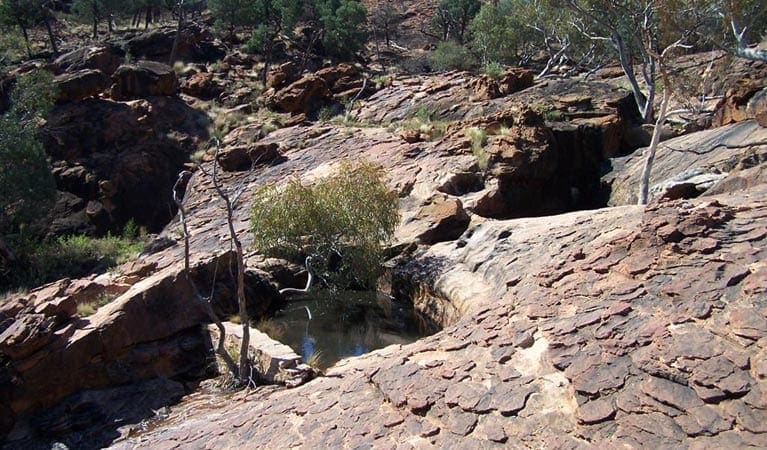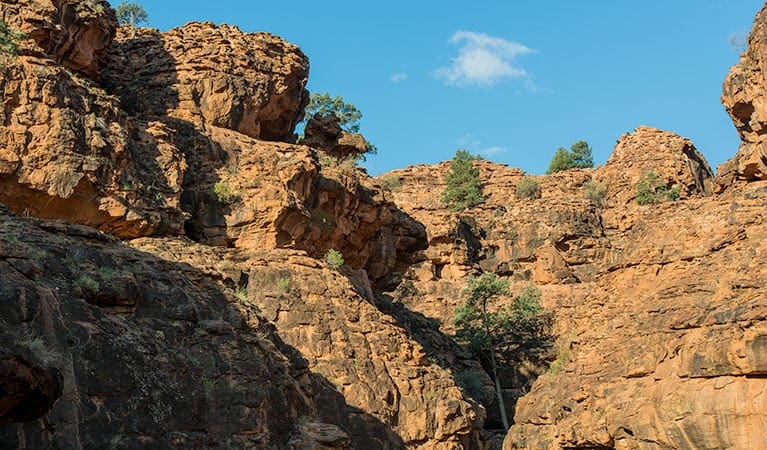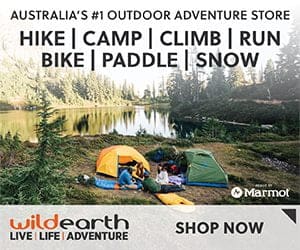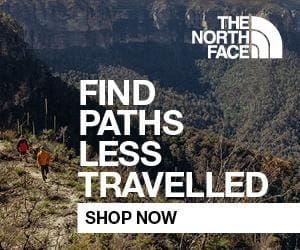Trail Fast Facts
Bynguano Range walking track is a 9km, grade 5 hike in Mutawintji National Park, New South Wales. This hike typically takes 4 hours to complete.
Hike Overview
The Bynguano Range Walking Track in Mutawintji National Park, New South Wales, offers a challenging 9km (grade 5) adventure with breathtaking panoramic views. Expect to spend roughly 4 hours traversing this scenic yet demanding trek. This particular hike includes a short return walk out to Big Rock Pool, making the overall length 9km.
The trail begins leisurely, meandering alongside the craggy cliffs of Homestead Creek. Look closely for the impressive Aboriginal rock art at Thaaklatijika overhang, a testament to the area's rich cultural history. As you embark on the steeper climb over the Bynguano Range, prepare to be awestruck by the spectacular maze of valleys and rugged gorges unfolding beneath you. Keep your eyes peeled for native wildlife – kangaroos and emus graze in the grassy woodlands, and you might even spot the elusive yellow-footed rock wallaby.
Find a scenic spot to rest and refuel while listening to the vibrant birdlife. The unmistakable chatter of the colorful corellas might fill the air, while you may also catch a glimpse of a majestic wedge-tailed eagle or a peregrine falcon soaring overhead.
Due to the challenging nature of the terrain, this hike is recommended for experienced bushwalkers with a good level of fitness. Be sure to check weather conditions before setting off and bring plenty of water and snacks.
Track Grade
Grade 5 (Difficult) - Walks for the Most Experienced: Grade 5 represents the most challenging walking tracks on the AWTGS. These are only recommended for very experienced and fit walkers with specialised skills, including navigation and emergency first aid. Tracks are likely to be very rough, very steep, and unmarked. Walks may be more than 20 kilometers. These challenging walks demand a high level of fitness and experience to navigate difficult terrain, significant elevation changes, and potentially unformed paths.
Tips
- Mutawintji National Park is best visited during autumn, winter and spring when daytime weather is pleasant. Summer in the outback can be very hot. Outback NSW can be very hot in summer. If travelling at this time be well prepared for the extreme conditions.
- In wet weather, access within the park maybe closed, and the public roads are susceptible to weather closures. Please check with the park office before you head out.
- Remember to take your binoculars if you want to bird watch.
- Toilets and picnic facilities are located at the Homestead Creek campground.
Map and GPX file
Max elevation: 312 m
Min elevation: 210 m
Total climbing: 231 m
Total descent: -232 m
Trail Location (trailhead)
Sorry, no records were found. Please adjust your search criteria and try again.
Sorry, unable to load the Maps API.
Getting there
Bynguano Range walking track is an extension of the Thaakalatjika Mingkana walking track in Mutawintji National Park. To get there, simply continue past the visitor center for about 2 kilometers along the main road. You'll find the designated parking area and trailhead conveniently located at Homestead Creek picnic area on your right. Remember, since the access road is unsealed, checking weather conditions beforehand is crucial to ensure a smooth journey.
Accessing Mutawintji National Park: Mutawintji National Park is approximately 130 kilometers northeast of Broken Hill. The journey is via an unsealed gravel road, typically well-maintained in dry weather. However, heavy rain can cause closures. Always check road conditions with local authorities before venturing out. Drivers from Broken Hill have two route options: follow the Silver City Highway towards Tibooburra, keeping an eye out for the well-marked Mutawintji National Park turnoff. Alternatively, take the Barrier Highway for 75 kilometers before turning onto the designated park access road.
Upon arrival at the park, Mootwingee Road serves as the main entry point. Parking options include Homestead Creek campground and picnic area. While two-wheel drive (2WD) vehicles can access the park, remember these are unsealed roads. Extreme weather conditions can significantly impact road quality. Park access is restricted to dry weather only, as heavy rain can make the unsealed roads impassable.
Photo gallery
If you have any photos from this hike and are happy to share them, please upload your .jpg files here.
Please note: Uploading photos does not transfer ownership of copyright away from you. If requested, you will be credited for any photos you provide and can ask they be deleted at any time.
About the region
In the rugged outback of New South Wales, Mutawintji National Park offers a uniquely Australian experience. This ancient landscape, northwest of Broken Hill, boasts a rich Aboriginal heritage spanning millennia. Evidence of their presence can be found throughout the park, from significant cultural sites to famous hand stencil art adorning the vibrant red cliffs of the Bynguano Ranges.
Mutawintji National Park showcases the classic Australian outback. Explore a network of red dirt roads, winding through dramatic gorges and vast deserts. The ever-changing hues of the Bynguano Ranges paint a majestic backdrop, while the expansive saltbush and mulga plains stretch endlessly towards the horizon, offering a true escape from the hustle and bustle of city life.
The park holds deep cultural significance for the traditional owners, the Pantjikali, Wanyuparlku, Wilyakali and Malyangapa people. For thousands of years, Mutawintji has served as a crucial meeting place for Aboriginal communities, hosting gatherings of up to 1,000 people for ceremonies like initiations and rainmaking rituals.
An easy walk, suitable for wheelchairs, leads you to the splendor of Mutawintji's gorges and the rocky overhang known as Thaaklatjika (Wright's Cave). Here, captivating artworks – paintings, stencils, and engravings – depict the rich history of the area, showcasing both pre-colonial and colonial Aboriginal life alongside native animals like kangaroos and emus.
Despite its peaceful ambiance, Mutawintji is teeming with wildlife. Look out for soaring predators like wedge-tailed eagles and peregrine falcons. The air comes alive with the calls of noisy short-billed corellas, zebra finches, budgerigars, apostle birds, and magpies. Keep an eye out for slithering goannas and snakes, and don't miss the chance to spot members of the endangered yellow-footed rock wallaby – the largest and brightest-colored rock-wallaby in Australia, found only on the park's rocky ridges.
Begin your exploration at the Mutawintji Visitor Centre to gather valuable information and park permits. Choose from a variety of campsites, including Homestead Creek campground. Hiking options cater to all abilities, ranging from the easy Thaaklatjika Mingkana walking track to more challenging adventures like the Rockholes Loop walking track or Mutawintji Gorge walking track.
Similar trails nearby
Explore Safe
While planning your hike, it’s important to check official government sources for updated information, temporary closures and trail access requirements. Before hitting the trail, check local weather and bushfire advice for planned burns and bushfire warnings and let someone know before you go. Plan ahead and hike safely.
Let someone know
Adventure with peace of mind: Fill out your trip intentions form. Before you hit the trail, fill out an online form to privately send important details about your hike to your family or friends. If you don’t return on time, they can easily alert emergency services, preventing worry and ensuring a swift response. Hike with peace of mind and enjoy your outdoor adventure to the fullest. Be smart, be safe: Register your plans here.
Gear to consider
What you carry in your pack will depend on the weather, terrain, time of year, type of adventure, and personal preferences. Having trouble deciding what gear’s right for you? My free planning, food and packing checklists provide an introduction to things your could consider (as well as the Ten Essentials) on your day, overnight and multi-day adventures. Customise your kit according to your personal needs, always considering safety first.
Suggest an edit
Trail changed? New features discovered? Has the route changed? Trail permanently closed? Help fellow hikers by suggesting edits! Click above to update route descriptions, GPX file, trail features (like boardwalks), or access conditions (like parking availability). Help me keep the trails info fresh!
Weather
Acknowledgement of Country
Trail Hiking Australia acknowledges the Traditional Owners of the lands on which we hike and pay respects to their Elders, past and present, and we acknowledge the First Nations people of other communities who may be here today.











